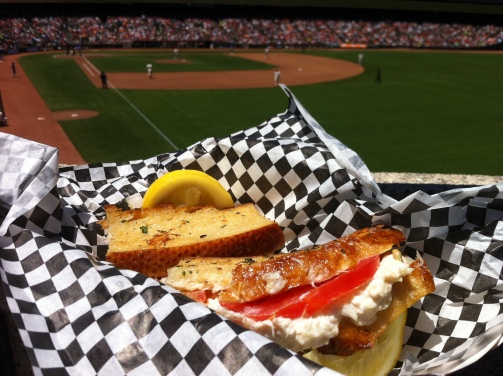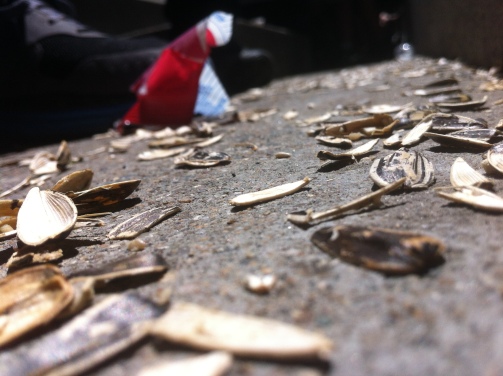My first week at Saison in a nutshell:
- Perfection, perfection, perfection. Nothing can ever be TOO perfect.
- When picking leaves, flower petals, herbs, etc.: any blemishes, folds, rips, or uneven edges… THROW IT AWAY. Waste is not an issue when it comes to perfection.
- There is a fine line between speed and accuracy. To work at Saison, you have to meet that line or else all sorts of hell will be unleashed.
- Always keep flowers refrigerated and moist with “fish paper” misted with water (still don’t know why it’s called fish paper.. they just look like super fine paper towels).
- Forceps are your best friend.
- If there’s anything worse than shucking peas… it’s double-shucking them. First remove them from the large, chalky outer shell, blanch and shock them, then remove the individual peas from their skins. Just to get a pint of shelled peas, I need to double shuck a whole quart of them. Best. Job. Ever.
- Juicing rhubarb: load juicer slowly. If you feed the juicer too fast, the pulp from the fibrous stalk will collect on one side of the spinning blade and cause intense shaking (and not a very good sound either). It’s kinda like when your washing machine is not balanced and it bounces off the walls during the spin cycle. Same concept.
- Stinging nettles cannot be eaten raw. Leaves should be picked off and thoroughly rinsed in water and then cooked. Picking nettles should be done with gloves and is also considered a legal form of torture (according to me at least).
- When your schedule says 8:30 am – 8 pm, don’t expect to be going home before 10.
- Topping eggs.. another legal form of torture.
- 65.5 hours in 5 days… only 434.5 to go.









12
Jun
10 Signs of Mediocrity
How to spot a mediocre restaurant (and stay away from it) — according to Pim Techamuanvivitin in The Foodie Handbook: The (Almost) Definitive Guide to Gastronomy (with added personal commentary by me :))
No, not those unctuous chocolate truffles that typically pop up in places like Costco for the holiday season. I’m referring to the Black Perigold truffles, the black gold fungus from France. With eating seasonally trending nowadays, seeing truffles on a menu when it’s not in season is a red flag. A notoriously expensive specialty such as the truffle, you can only assume that a restaurant that’s desperate enough to keep it year-round isn’t giving you the real deal. Sure, some claim that the truffle smells like a smelly sock or even a fresh armpit.. but there’s nothing more disappointing than being over-charged for cheap gimmicks like stale truffle oil. Personally, I have never tried a REAL truffle from France (running at $85 per ounce, or $4,200 per kilo), but if and when I do, it’ll definitely be worth it.
Unfortunately, I have fallen prey to this con one time too many, but just to name a few: Sky City atop the Space Needle in Seattle, Top of the World at the Stratosphere in Vegas, and Forbes Island which involved dining UNDERWATER in San Francisco’s Fisherman’s Wharf. Too young to know any better, the only real novelty was the unique dining atmosphere. The theatrics of the meal was nothing short of forgettable. If you have money to blow or just want to entertain your inner tourist, by all means, dine at Jules Verne on top of the Eiffel Tower! But guaranteed you’re paying for the view, not the day-old croissants they tricked you into eating.
It’s like the all encompassing adjective of restaurant jargon. Words like “organic” and “sustainable” need to be authorized before being put onto menus.. but who’s monitoring the use of “gourmet”?! It’s like saying shoulder pads are classy (which they totally are not). Just because you added two drops of truffle oil to your mashed potatoes doesn’t make it gourmet. Also, be particularly wary when “gourmet” is applied to an ethnic cuisine, such as a gourmet Indian restaurant, for example. In such a case it usually just means they’ve added a tablecloth and perhaps a better brand of soap in the restroom, all of which can result in a massive increase in menu prices. No bueno.
There are good fusion restaurants and then there are not so good ones. One combination that usually works is French and Vietnamese. One that doesn’t and should never work is Italian and Indian. In any case, be warned. Not all fusion restaurants are a home run. They usually claim to do so many things they can’t help but be mediocre at pretty much all of them.
Any menu that has to be spiral bound isn’t considered a menu. Case in point, The Cheesecake Factory. The one time I ate there, it took me 20 minutes to order because I was so conflicted on what to order, I forgot that I was even hungry in the first place. Sure, some might argue that places like The Factory provide a great variety for large parties. What guests don’t realize is that the exotic fish they just ordered was probably entombed in the freezer for years prior to it being defrosted in a microwave then slapped on the grill for that “pan-seared” authenticity. It is not entirely practical for a restaurant to stock every conceivable ingredient known to mankind in order to support the length of The Odyssey. An extensively long menu is also a sign that the chef, like any bad writer or artist, doesn’t know how to edit himself.
If you see kangaroo on the menu and you’re not in Australia.. DON’T EAT THERE. Not to say that a native of Australia can’t come to California and share this unique and disturbing mutilation of cute, fluffy creatures… but more likely than not, ingredients like kangaroo or alligator on a menu is meant to spike curiosity, not excite the taste buds.
Good restaurants don’t need to have people standing by the front door waving hello to tourists and beckoning them to come in (or even standing on street corners handing out coupons). It’s usually the other way around. Fabulous restaurants go to great lengths to find gatekeepers to prevent people from entering, albeit in the most tactful way possible.
Hard Rock Cafe. Need I say more?
This is particularly worrying if said gift shop carries fluffy stuffed animals bearing the name or insignia of the restaurant. But there is an exception to this rule, however. Many three-star restaurants in the French countryside feature a shop selling local products or special ingredients created by the chef are never short of exquisite. Still, most restaurants with gift shops attached are, well… Hard Rock Cafe, anyone?
As a general rule, an empty restaurant is quite likely a mediocre one as well. Don’t assume that you’ll find an undiscovered gem hiding in the dirt while traveling in some exotic locale. If the restaurant were any good, someone else, most likely the locals, would have found out before you.
12 years ago Short URL Comments
cheap gimmicks/commentary/food/foodie/funny/guide/handbook/mediocre/pim/restaurant/restaurants/travel/vacation